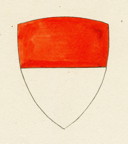Gemma Donati
Gemma Donati | |
|---|---|
 The Donati coat of arms | |
| Born | c. 3 March 1265 Florence, Italy |
| Died | after 1333 |
| Nationality | Florentine |
| Spouse | Dante Alighieri |
| Children | At least 4, including Jacopo Alighieri |
Gemma Di Manetto Donati, commonly shortened to Gemma Donati (c. 3 March 1265 – after 1333), was the wife of Italian poet Dante Alighieri.
Biography[edit]
Gemma Donati's life is relatively undocumented. Throughout his life, Dante never mentioned Donati. Instead he wrote prolifically about his love-interest and muse Beatrice Portinari, whom he met when he was nine.[1][2]
Donati was born to Manetto and Maria Donati in around 1267, two years after her future husband, Dante Alighieri. The Donati family was a wealthy family in medieval Florence. She was betrothed to Dante in 1277[3] when he was either 11[4] or 12 years old. Her dowry was only 200 florins, which suggests that Dante's family had no substantial assets by the mid-1270s. Nevertheless, an alliance with the Donati family through marriage was socially prestigious.[5] Since the Donati family owned a lot of land in Florence and made money through renting, it is very likely that the Donatis were the landlords of the Alighieri home. The couple were married sometime around 1285 while they were in their early 20s.
Accounts vary as to how many children and Donati and Dante had, but they had at least four children:[6]
- Pietro (c. 1286)
- Giovanni (c. 1288)
- Jacopo (c. 1300)
- Antonia (c. 1300)
There has been discussion among scholars of whether or not the marriage between Donati and Dante was a happy one. In Boccaccio's Trattatello in laude di Dante, Boccaccio writes that Dante's relationship with Donati only brought him trouble and pain. Despite this claim, there is no firm evidence that the marriage was not a happy one. There is evidence that Dante was on good terms with Donati's family, as in the 1290s Manetto Donati gave Dante several loans.[5]
When Dante was exiled from Florence in 1301, Donati and her children did not join him, and it is probable that Donati never saw her husband again.[7] She entered a convent in Ravenna later in her life. Documents suggest that as of June 1333 she was alive; however, her exact death date is unknown.[8]
Dante would represent her as the Virgin Mary in the Canto XXIII of the Paradiso, as "introduction" to the representation of their children Pietro, Jacopo, Giovanni, represented in the following Cantos by the respective saints, and Antonia, represented by Beatrice and Adamo.[9]
References[edit]
- ^ "Dante Alighieri". Florence Inferno. 2014-09-29. Retrieved 2020-06-26.
- ^ "Dante's New Love Life: the Vita Nuova - Italian Stories". Beyond Foreignness. 2019-04-15. Retrieved 2020-06-28.
- ^ Hainsworth, Peter; David, Robbey (2015). Dante: A Very Short Introduction. OUP Oxford. ISBN 978-0191507670.
- ^ Wilson, A.N. (2011). Dante in Love. Atlantic Books Ltd. p. 56. ISBN 978-0857895813.
- ^ a b Dixon, Richard (2016). Dante: The Story of His Life. Harvard University Press. pp. 41, 42. ISBN 978-0674504868.
- ^ Chance, Jane (2019). Medieval Mythography, Volume Three: The Emergence of Italian Humanism, 1321-1475. Wipf and Stock Publishers. p. 47. ISBN 978-1532688973.
- ^ Toynbee, Naget (1966). Concise Dictionary of Proper Names and Notable Matters in the Works of Dante. New York: Phaeton Press. p. 177.
- ^ Ruud, Jay (2008). Critical Companion to Dante. New York: Infobase Publishing. p. 437. ISBN 978-1438108414.
- ^ Lombardi, Giancarlo (2022). L'Estetica Dantesca del Dualismo (in Italian) (1st ed.). Borgomanero, Novara, Italy: Giuliano Ladolfi Editore. ISBN 9788866446620.
